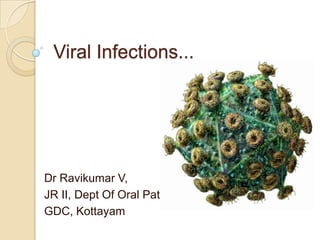Viral infections of Oral Cavity
- 1. Viral Infections... Dr Ravikumar V, JR II, Dept Of Oral Path, GDC, Kottayam
- 2. Intro ’éŚ What is a Virus..? ’éŚ Basic structure ’éŚ Sequlae of infection ’éŚ Classification
- 3. Herpes Simplex ’éŚ HSV I and II ’éŚ Skin, mucosa, eye and CNS
- 6. ’éŚ Herpes genitalis ’éŚ Herpes meningoencephalitis ’éŚ Herpetic conjunctivitis
- 7. ’éŚ Herpetic eczema ’éŚ Disseminated HS of newborn ’éŚ Herpetic whitlow ’éŚ Herpes gladiatorum
- 8. Primary Herpetic Stomatitis ’éŚ Infancy and adult ’éŚ Spread ŌĆō droplets, contact ’éŚ Fever, irritation, headache, pain on swallowing, regional lymphadenopathy ’éŚ Yellow fluid filled vesicles which rupture to form characteristic ulcers
- 10. ’éŚ HSV culture from sites ’éŚ HSV DNA demonstration in lumbar and trigeminal ganglia ’éŚ Histology ŌĆō ballooning degeneration - Lip schutz bodies Diagnosis ŌĆō clinical, stains, cytology, DNA, PCR Treatment ŌĆō Antiviral drugs, NSAID
- 11. Reccurent Herpes Labialis / Stomatitis ’éŚ Attenuated form of primary disease ’éŚ Reactivation ŌĆō ganglion trigger, skin trigger, emotional theory ’éŚ The viruses spread through nerves and act on epithelial cells and cause inflammation
- 12. ’éŚ Lesions may recur at any interval ’éŚ May occur on lips, intraoral, or along area of distribution of nerve ’éŚ Preceded by tingling or burning sensation
- 13. ’éŚ Vesicles less than a mm appear as clusters which coalasce ’éŚ Associated pain ’éŚ Lesions heal by a week
- 14. Diagnosis ’éŚ Histology ’éŚ Viral identification and isolation ’éŚ Immunofluorescent tests ’éŚ Immunoperoxide test ’éŚ RIA and ELISA ’éŚ Treatment
- 15. Herpangina ’éŚ Coxsakie group A virus ’éŚ Ingestion, contact, droplet ’éŚ Seen in summer, in young ’éŚ Symptoms ŌĆō sore throat, cough, rhinorhea, fever, vomiting and even abdominal pain ’éŚ Vesicles which rupture to form ulcers ’éŚ All of these heal by 7 days
- 16. ’éŚ No treatment needed as it is self limiting
- 17. Hand Foot and Mouth Disease ’éŚ Coxsakie and entero virus ’éŚ Multiple ulcers with dysphagia ’éŚ Intracytoplasmic viral inclusions, high antibody titer to Coxsakie ’éŚ Self limiting
- 18. RUBEOLA (MEASLES) ’éŚ produced by a paramyxovirus ’éŚ Affected individuals are infectious from 2 days before becoming symptomatic until 4 days after appearance of the rash ’éŚ Incubation period of 8 to 12 days
- 19. ’éŚ Pre erutive, eruptive and post eruptive stage ’éŚ Small red macules or papules appear which enlarge and coalesce to form irregular lesions which blanch on pressure and gradually fade in 4 or 5 days. ’éŚ KoplikŌĆÖs Spots ’éŚ Warthin Finkeldey giant cells
- 21. RUBELLA (GERMAN MEASLES) ’éŚ capacity to induce birth defects ’éŚ Forchheimer spots- small discrete dark-red papules that develop on the soft palate and may extend onto the hard palate
- 22. ’éŚ The classic triad of CRS consists of deafness, heart disease, and cataracts
- 23. Molluscum Contagiosum ’éŚ Caused by virus of pox group ’éŚ Considered tumor like ’éŚ Occur as single or multiple discrete elevated nodules with central crustation ’éŚ Cowdry A inclusion bodies ’éŚ Henderson Paterson inclusions
- 25. Varicella
- 26. ’éŚ Oral lesions
- 27. Herpes Zoster ’éŚ James Ramsay HuntŌĆÖs syndrome
- 28. ’éŚ Tzank smear
- 29. Mumps
- 30. Non Specific Mumps ’éŚ C/c Non Specific Sialadenitis ’éŚ Acute Post operative Parotitis ’éŚ Nutritional Mumps ’éŚ Chemical Mumps ’éŚ Miscellaneous
- 31. ’éŚ Human Immuno Deficiency Virus ’éŚ Etiologic agent of Acquired Immunodeficiency Syndrome (AIDS). ’éŚ Characterized by severe depletion of CD4 cells.
- 33. MODES OF TRANSMISSION ’éŚ Sexual transmission ’éŚ Blood or blood products ’éŚ Maternal-fetal ’éŚ Infected needles
- 35. CLASSIFICATION OF CLINICAL MANIFESTATIONS ’éŚ Group I : Acute Infection ’éŚ Group II : Chronic Asymptomatic Infections ’éŚ Group III : Persistent Generalized Lymphadenopathy ’éŚ Group IV : Aids Related Complex
- 37. CHRONIC ASYMPTOMATIC INFECTIONS ’éŚ Most dangerous group ’éŚ Seropositive pt who is apparently healthy capable of infection ’éŚ Enlarged axillary glands ’éŚ Hematological & immunological abnormalities
- 38. PERSISTENT GENERALISED LYMPHADENOPATHY ’éŚ LYMPHADENOPATHY in 2 or more extrainguinal sites persisting for more than 3 months
- 39. AIDS RELATED COMPLEX ’éŚ OPPORTUNISTIC INFECTIONS -Pneumonia, Cryptococcosis, Viral Infections, Toxoplasmosis, TB etc. ’éŚ NEOPLASMS - KS, Lymphoma, SCC
- 40. ’éŚ NEUROLOGIC DISEASES - Meningocephalitis ’éŚ OTHERS - Encephalopathy, Purpura, Thrombocytopenia
- 42. ’éŚ Oral lesions in HIV...
- 44. HISTOPLASMOSIS ’éŚ Histoplasma capsulatum Nodules over the mucosa which undergoes ulceration Gingiva, tongue, palate, buccal mucosa
- 45. LINEAR GINGIVAL ERYTHMA Very fine red band along gingival margin and attached gingiva with profuse bleedin
- 46. NECROTIZING ULCERATIVE PERIODONTITIS Advanced destruction of peridontium, rapid bone loss, loss of PDL
- 49. WART (HPV)1 Painless papule or nodule with papillary projections or rough surface Pedunculated or Sessile
- 50. APHTHOUS ULCER (MINOR) Single or multiple recurrent ulcers with whitish pseudomembrane & surrounded b Erythamatous halo mostly seen on cheek, tongue, soft palate, tonsils.
- 52. KAPOSIŌĆÖS SARCOMA ’éŚ Predominantly in homosexuals. ’éŚ lesions are vascular, angiomatous neoplasms that begin as red macule & progress to large tumefactive red & purple lesions. ’éŚ Oral lesions: multifocal & typically seen on palate & gingiva
- 53. LYMPHOMA ’éŚ Most are of B cell origin and Epstein-Barr virus occurs in cells from several cases. ’éŚ Lymphoma can occur anywhere in the oral cavity & there may be soft tissue involvement with or without involvement of underlying bone.
- 54. Diagnosis of HIV ’éŚ Viral Culture ’éŚ PCR ’éŚ P24 antigen detection ’éŚ ELISA ’éŚ Western Blot Treatment - HAART
- 55. TREATMENT ’éŚ Haart - zidovudine, stavudine, lamivudine, didanosine ’éŚ Symptomatic treatment ’éŚ Precautions
- 56. Thank u...
























































